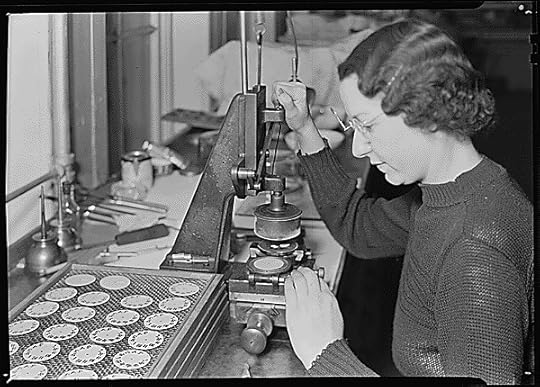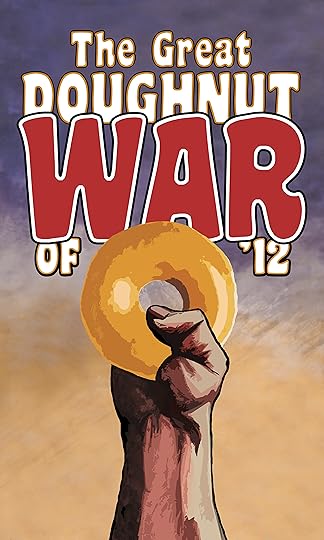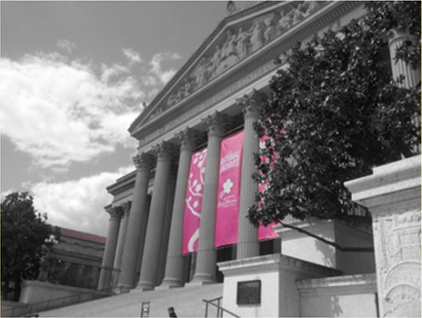David S. Ferriero's Blog, page 32
October 9, 2012
American Archives Month
October is American Archives Month, a time when we celebrate the work that archivists all over the country do to ensure that the records of their institutions are created, collected, and protected in a manner that allows their clientele to find what they need. Here at the National Archives that means ensuring that citizens can hold our government accountable, can learn from our history, and can explore family histories, to name just a few ways the records are used.
What do I love about the National Archives? The discoveries made every day in the records of our country, such as:
Last week a veteran arrived in College Park by motorcycle from Nevada. He has been searching for 43 years for information about his platoon leader killed in Viet Nam. The staff found the information he needed “in 30 seconds!”
An archivist in St. Louis learned of a family bible in our pension claim records for his Revolutionary War ancestor
Letters with checks for the pennies collected by school children, teachers, and Elks Lodges around the country in a campaign to save the Navy’s oldest ship, the U.S.S. Constitution during the late 1920s.
The fact that my grandfather, Paolo Ferriero, was 15 years old when he arrived in Boston from Naples in 1903. And that he was met by his father, Antonio, who had arrived

September 28, 2012
By The Numbers
This is a snapshot of a variety of data points we are tracking to measure how we are doing. I am especially interested in trends as we focus more and more on digital access. Is the investment paying off in terms of numbers of eyeballs on our content? What impact does online access have on onsite visits? Are our efforts around social media paying off? Are we finding the people where they are? And making it easy for them to discover our content? And what difference has having a Wikipedian-in-Residence had?! You be the judge.
Crunching the numbers.
“Lancaster, Pennsylvania – Hamilton Watches.” Record Group 69: Records of the Works Progress Administration, 1922- 1944. National Archives, ARC ID 518443
Percentage of online users visiting archives.gov via mobile device in FY11: 4.6
Percentage of online users visiting archives.gov via mobile device in FY12: 10.2
Number of visits to all NARA facilities in FY11: 3,048,906
Number of visits to all NARA facilities so far in FY 12: 2,807,685
Number of visits Archives.gov in FY 11: 18,372,040 (so far in FY 12: 23,138,185)
Number of researcher visits to all NARA facilities in FY 11: 129,435
Number of written requests answered by all NARA offices in FY 11: 1,300,803
Number of written requests (includes fax, letter, email) received by all NARA archival offices in FY

August 30, 2012
Releasing All We Can, Protecting What We Must
The Information Security Oversight Office (ISOO) of the National Archives is responsible to the President of the United States for policy and oversight of the Government-wide security classification system. An open society in which the American public is informed and holds our government accountable is a defining factor of our democracy. Our ability to share information must be balanced by the need to hold certain information in confidence for periods of time to protect from harm our citizens, our democratic institutions, and our participation in the community of nations. ISOO ensures the development and application of policies which balance the disclosure, sharing, and protection of information related to national security.
President Obama issued Executive Order 13526 in December of 2009 calling for the first ever comprehensive Fundamental Classification Guidance Review (FCGR) of classification guidance across the Executive Branch of the government. These reviews are conducted to ensure that classification guidance reflects current circumstances as to what needs to remain classified and to identify classified information that no longer needs protection and can be declassified.
The first FCGR has now been completed and the agency reviews summarizing their reviews are available at http://www.archives.gov/isoo/. Altogether, 3,103 classification guides were reviewed and 869 were either cancelled or consolidated.
This review is an investment in the future health of the classification system. It provides a… [ Read all ]

August 24, 2012
Records Management with a Backbone
In his Memorandum on Managing Government Records, President Obama stated “…proper records management is the backbone of open Government.” The Memorandum began an executive branch wide effort to reform records management policies and practices and required each agency to:
identify a senior official responsible for records
provide plans for improving or maintaining its records management program, especially electronic records; and
suggest obstacles to sound, cost effective management policies and practices
Finally, the Memorandum mandates that the Director of the Office of Management and Budget (OMB) and I issue a Records Management Directive which focuses on:
creating a Government wide records management framework that is more efficient and cost effective
promoting records management policies and practices that enhance the capability of agencies to fulfill their statutory missions
maintaining accountability through documentation of agency actions
increasing open Government and appropriate access to Government records
supporting agency compliance with applicable legal requirements related to the preservation of information relevant to litigation; and
transitioning from paper-based records management to electronic records management where feasible.
I am pleased to report that this morning Jeffrey Zients, Acting Director of OMB and I issued the Managing Government Records Directive. With lots of hard work on the part of National Archives and Records Administration, White House, Federal agency staffs and stakeholder groups, the directive charts new directions… [ Read all ]

Capturing Living Memory
Colleen Wallace Nungari’s painting, Dreamtime Sisters, was selected as the “brand” for the International Council on Archives Congress which closes today in Brisbane, Australia. More than 1,000 archivists from 95 countries gathered to dream about the future around the theme, “A Climate of Change.”
Dreamtime Sisters, by Colleen Wallace Nungari
I was particularly struck by the theme of Nungari’s artwork and the relationship to the week’s deliberations. Dreamtime, in Aboriginal culture, described the period before living memory when the earth and all living things were created by Spirits from above and below. Dreamtime stories embody the culture and customs passed down and celebrated to this day.
Against that backdrop, as the group gathered for the opening session where I was invited to speak about social media, I encouraged them keep that image in mind as we deliberated on the state of the art of preserving today’s and tomorrow’s “living memory.” Honor the past as we create the future.
Read the full text of my address at the International Council on Archives Congress in Brisbane, Australia.

July 18, 2012
Wikimania 2012
Last Saturday I spoke to an enthusiastic crowd of Wikimedians at the Wikimania 2012 Conference here in Washington. Over 1400 people from 87 countries came together to talk, hack, and share their expertise and experiences at the week-long event. I was glad to share in their joie de vivre and to talk about our common missions at the closing plenary session.
Check out the enthusiasm for the National Archives at Wikimania 2012:
So you may be asking why the Archivist of the United States is so interested in working with the Wikimedia Foundation. As I noted at the conference, 42% of Americans turn to Wikipedia for information.* It is a terrific way to make Archives content more transparent and available. If we are serious as an agency about our mission to provide access to permanent federal records, and indeed we are, then we must consider working with the community and using the power tools available through the Wikimedia Foundation.
Our Wikipedian in Residence (pictured above) has already worked with our staff to upload over 90,000 digital copies of our records to the Wikimedia Commons for use in Wikipedian articles. We have several more projects in the pipeline, too, all in an effort to increase access to our records.
Here’s what I said to the crowd Saturday afternoon:
The conference had a robust backchannel of… [ Read all ]

July 3, 2012
Bonfires and Illuminations
On the second of July in 1776 John Adams wrote from Philadelphia to his wife Abigail his predictions on how the signing of the Declaration of Independence would be commemorated:
“I am apt to believe that it will be celebrated, by succeeding Generations, as the great anniversary Festival. It ought to be commemorated, as the Day of Deliverance by solemn Acts of Devotion to God Almighty. It ought to be solemnized with Pomp and Parade, with Shews, Games, Sports, Guns, Bells, Bonfires and Illuminations from one End of this Continent to the other from this Time forward forever more.
You will think me transported with Enthusiasm but I am not. I am well aware of the Toil and Blood and Treasure, that it will cost Us to maintain this Declaration, and support and defend these states. Yet through all the Gloom I can see the Rays of ravishing Light and Glory. I can see that the End is more than worth the Means. And that Posterity will tryumph in that Days Transaction, even although We should rue it, which I trust in God We shall not.”
I am fortunate to be daily “transported with Enthusiasm” because I get to wander into the Rotunda and observe the thousands of people who come to see the original Declaration of Independence. Even in its faded state after 236… [ Read all ]

June 14, 2012
Beer, Doughnuts, and the War of 1812
Last week the staffs of the National Archives and the Canadian Embassy here in Washington gathered to commemorate the War of 1812 in a special way—The Great Doughnut War of ’12, pitting Dunkin’ Donuts and Krispy Kreme against Tim Hortons. Three celebrity judges—two from the National Archives and one from the Canadian Embassy participated in a blind taste testing (below left).
And the attendees all had a chance to vote (ballot box, above right) as the doughnuts were served on separate unlabeled platters. Lest you think the two to one odds—doughnuts and judges—were unfair, let me point out that the event was held in MY HOUSE!
The tension built during the day when we learned that the delivery of Tim Hortons to the Embassy resulted in potential disaster.
Claiming SABOTAGE by the competition, the resourceful Embassy staff hoofed it to Baltimore for replacements.
We treated our Canadian friends to a display of facsimiles of records pertaining to the War of 1812 and beer!
And we ended the evening with a special screening of my favorite movie, “Strange Brew”—the source of everything I know and love about Canada!
P.S. Tim Hortons was the victor—both… [ Read all ]

June 8, 2012
Solving the Problems of Our Time
On his first day on the job President Barack Obama told his Senior Staff,
“Our commitment to openness means more than simply informing the American people about how decisions are made. It means recognizing that Government does not have all the answers, and that public officials need to draw on what citizens know. And that’s why, as of today, I’m directing members of my administration to find new ways of tapping the knowledge and experience of ordinary Americans—scientists and civil leaders, educators and entrepreneurs—because the way to solve the problems of our time, as a nation, is by involving the American people in shaping the policies that affect their lives.”
Knowing we don’t have all the answers, we’re changing the way we think about our work at the National Archives and Records Administration. We’re shifting our perspectives to reflect the fact that we do not have all the answers. The principles of open government – transparency, participation, and collaboration – help us draw on what citizens know.
Today, we release our updated Open Government Plan for 2012-2014. Looking back over the past two years, I’m proud of our accomplishments in strengthening open government in our agency and in our society. We set an ambitious path, accomplishing almost 70 tasks. Over the next two years our work will include:
Creating a new culture

May 29, 2012
Look Down
As a kid I had a “talent” for finding four leaf clovers. Stretching before a run recently I looked down and noticed one staring me in the face. And reconnected with my childhood. In fact, over the past weekend I found 23!
According to my favorite encyclopedia, Wikipedia, 1 in 10,000 clovers has four leaves. Legend has it that three leaves represent faith, hope, and love. The fourth: luck!
We are surrounded every day with messages to “look up,” “look ahead,” “look back,” but not so many to “look down.” Except “mind the gap!” A quick Google search for “look up” results in 560m hits while “look down” only 231m hits. So, while you are looking up for inspiration or ahead for direction or back for perspective, remember to look down. It is amazing what’s at your feet!

David S. Ferriero's Blog











